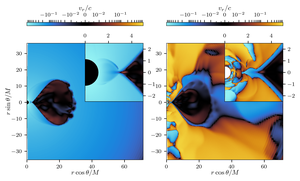
All large galaxies contain a supermassive object in their nucleus. Some of these are very powerful emitters of light and other forms of radiation, they are then called active galactic nuclei (AGNs). The authors address the nature of these objects, and examine whether the presence of a black hole best explains the activity in galactic nuclei.
How compact these supermassive objects are has recently been revealed by observations of the nearby Galaxy M87, and the center of our own Galaxy (Sagittarius A*), performed by the Event Horizon Telescope collaboration. The inner edge of the iconic image of the core of the M87 galaxy has the size of the orbit of Neptune, the outer planet in our Solar system. And yet, inside this tiny (astronomically speaking) circle is present a mass of one billion Suns. This mass is so large that, as predicted by Einstein’s theory of gravity, a ray of light could go around it in a circle along the inner edge of the ring imaged by the Event Horizon Telescope.
It is generally accepted that the supermassive objects in the galactic nuclei may be black holes. This easily explains the huge observed brightness of AGNs, which would be powered by gas falling in the tremendous gravity of the supermassive object and being compressed and heated in the process. However, not all the features displayed by AGNs are as easily explained. For example, some of the infalling matter apparently turns around and leaves the system with extraordinarily high speeds of many thousands of kilometers per second. Another type of solution is possible, an electrically supercharged, supermassive, point-like object that is more compact than a black hole and does not have an event horizon; such objects are known as naked singularities.
Włodek Kluźniak and Tomasz Krajewski from Copernicus Astronomical Center in Warsaw, the authors of the paper: "Outflows from Naked Singularities, Infall through the Black Hole Horizon: Hydrodynamic Simulations of Accretion in the Reissner-Nordström Space-Time", published in the Physical Review Letters, perform computer simulations of the fate of the infalling gas, and find that a black hole tends to absorb nearly all of it, as it falls quickly through the black hole horizon (point of no return). However, a naked singularity has the unusual property that it gravitationally repels matter that approaches it “too closely” and this leads to its ejection from the system. More observations are needed to exclude naked singularities as engines of AGNs.
Figure caption:
Radial component of velocities (in units of the speed of light c) of matter infalling onto a black hole (left panel) and infalling onto or outflowing from a naked singularity (right panel). Black hole absorbs matter that falls onto its horizon. Naked singularity produces powerful outflows, ejecting matter that reaches its close neighborhood in which gravity is effectively repulsive. The black semicircle on the left panel covers the region below the event horizon. The green dotted line on the right panel marks boundary of the region in which gravity acts repulsively.
Text by Tomasz Krajewski
Illustration: Włodek Kluźniak and Tomasz Krajewski






